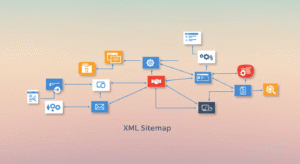What Are the 4 Pillars of SEO
Search Engine Optimization (SEO) is one of the most important parts of growing any website. It’s what helps people discover your content when they search on Google. Learning how SEO works means you’re taking control of how your website appears, how much traffic it gets, and how many visitors turn into real customers or clients. Four main areas make up a strong SEO approach, and understanding each one allows you to build a solid, long-term path to success. With the right approach, even small websites can improve their visibility, compete with larger ones, and see real growth over time.
The 4 Pillars of SEO at a Glance
To create an effective SEO strategy that truly works, you need to understand and apply the four key areas that form the basic foundations of SEO. These aren’t just terms or categories, they are practical actions you take to help your website perform better in search results. When these components of SEO work together, your chances of appearing on the first page of Google increase dramatically.
Understanding the types of SEO helps you focus your efforts on the areas that matter most. Whether you’re building a new website, managing an existing one, or just trying to increase your rankings, these are the areas to prioritize.
Here’s a quick overview of the four main types of SEO that every website needs:
| Pillar | Description |
| Technical SEO | Focuses on website infrastructure, crawlability, mobile-friendliness, and speed. |
| On-Page SEO | Optimization of content, headers, keywords, meta tags, and internal linking. |
| Off-Page SEO | Involves backlinks, social signals, and authority building. |
| Content | Creation of high-quality, user-intent-driven content using the best high-quality keywords. |
Pillar 1: Technical SEO – Make Sure Your Website Works Properly
This type of SEO focuses on how well your website is built. It’s about creating a smooth foundation that allows search engines like Google to crawl and index your pages correctly. Think of it like the plumbing and wiring behind the walls of a home; your visitors don’t see it, but everything depends on it working correctly.
For example, your page load speed plays a huge role here. A slow website doesn’t just annoy users, it tells Google that your site may not provide a good experience. Using trusted tools like Google PageSpeed Insights or GTmetrix can help you find ways to increase your page load speed, which improves both user satisfaction and rankings.
Another big part of technical SEO is mobile-friendliness. Since over 70% of total internet time is now spent on mobile devices, your site needs to look great and function smoothly on any screen. A responsive design adjusts your layout depending on the device being used, desktop, phone, or tablet, making sure users can navigate easily without frustration.
Also, don’t overlook simple but essential factors like clean website navigation, clear internal links, and SEO-friendly URLs. These may seem basic, but they’re part of the core search engine ranking factors that help both people and search bots find what they need quickly.
Pillar 2: On-Page SEO – Control What You Can See and Optimize
On-page SEO is the part most people are familiar with. It refers to everything on your website that you can adjust and improve directly, from your page content to the way it’s organized. This includes header tags, meta descriptions, title tags, images, keyword placement, and even the structure of your paragraphs.
A common mistake people make is writing content just for search engines. But Google is smarter now. It values content that’s clear, useful, and easy to read for humans. So instead of stuffing a page with keywords, focus on creating helpful content that answers a visitor’s question clearly and confidently. Use the best high-quality keywords, naturally woven into the content, that you find using tools like SEMrush, Ahrefs, or Google Keyword Planner.
Also, don’t forget meta descriptions. While they don’t directly impact rankings, they increase your CTR (Click-Through Rate) when they’re written well. A compelling meta description gives users a reason to click your page instead of someone else’s. Organizing content with header tags (H1, H2, H3) helps guide the reader through your page and signals the page’s structure to Google. Combined with logical internal linking, these strategies greatly improve user experience and help search engines understand the importance of each section of your site.
Pillar 3: Off-Page SEO – Build Your Website’s Reputation
While technical and on-page SEO happen within your website, off-page SEO focuses on your site’s reputation across the internet. It’s about how other websites talk about you and whether or not they trust your content enough to link to it.
The most powerful part of off-page SEO is building backlinks, links from other sites that point to your own. Not all backlinks are equal, though. A single link from a highly respected site (like a news outlet or niche authority) is worth far more than dozens of links from unrelated or low-quality sources. Off-page SEO also includes social media activity, online reviews, brand mentions, and how often your content is shared. All of these signals help build trust and tell Google your website is a reliable source of information.
Off-page SEO is your brand’s online reputation. When done well, it tells search engines you’re not just a random site, you’re a trusted voice that deserves to be seen and ranked higher than your competitors.
Pillar 4: Content – Give People What They’re Looking For
Even if your site is technically perfect and full of backlinks, you won’t go far without quality content. SEO and content go hand-in-hand, great content gives people a reason to stay on your site, link to it, and come back later. This is where your creativity and subject knowledge come into play.
Great SEO content doesn’t just fill space. It solves problems. It answers real questions. It speaks to the reader with honesty, clarity, and relevance. To do this well, focus on the user first, not just the keywords.
Start with thorough keyword research using reliable keyword research tools, and find out what your audience is searching for. Then write content that’s tailored to those needs, organized with clear header tags, and supported by data, examples, or actionable steps.
Update your content regularly to keep it fresh and relevant. Google prefers updated information, especially in fast-moving industries. Also, use visual aids like images, videos, infographics, or tables to break up long text and improve engagement.
SEO Essentials Checklist
| SEO Element | Best Practice |
| SEO-Friendly URLs | Short, descriptive, and include target keywords |
| Header Tags | H1 for titles, H2/H3 for structure |
| Meta Descriptions | 155-160 characters, emotional and action-based |
| Page Load Speed | Aim for < 2.5 seconds on both desktop and mobile |
| Keyword Research Tools | Ahrefs, SEMrush, Ubersuggest, Google Keyword Planner |
| Mobile-Friendliness | Responsive design and UX testing |
| SEO Checker | Use regularly to fix technical errors |
How to Build an Effective SEO Strategy
Written in a clear, beginner-friendly tone with useful steps, keyword integration, and EEAT-focused advice, ideal for both content teams and solo marketers.
How to Build an Effective SEO Strategy
Building a successful SEO strategy isn’t about ticking a few boxes or copying what your competitors are doing. It’s about connecting all four pillars of SEO, technical, on-page, off-page, and content, in a way that serves your audience first and makes your site genuinely useful and trustworthy. This process takes time, patience, and consistency, but the long-term rewards are worth it.
Here’s a more detailed, step-by-step breakdown of how to create an effective SEO strategy that helps you increase your rankings, improve visibility in SERPs (Search Engine Results Pages), and build a website people can trust.
1. Audit Your Website Using an SEO Checker
Before making improvements, it’s important to know where you stand. Run a full site audit using a reliable SEO checker like Ahrefs, SEMrush, Screaming Frog, or Google Search Console. This will uncover technical issues such as broken links, missing meta tags, duplicate content, slow page speeds, and mobile usability problems.
The audit acts like a health checkup. It gives you a clear view of your site’s weaknesses and where you need to focus first to lay down the basic foundations of good SEO.
2. Improve Technical Performance and Mobile-Friendliness
After your audit, fix the critical technical issues first. Start with page load speed, because even a one-second delay can hurt conversions and rankings. Use tools like Google PageSpeed Insights or GTmetrix to optimize images, reduce unnecessary scripts, and improve caching.
Make sure your site structure is clean and logical. Use clear menus, proper website navigation, and SEO-friendly URLs to help users (and Google) move smoothly through your pages.
3. Do Proper Keyword Research to Target the Right Audience
Start your content strategy by discovering what your audience is searching for. Use trusted keyword research tools like Ahrefs, Ubersuggest, or Google Keyword Planner to find the best high-quality keywords with good search volume and manageable competition.
Don’t just go for high-traffic keywords. Focus on intent-based terms, what the searcher truly wants. These keywords help you match your content to what users expect to find, which improves both your CTR (Click-Through Rate) and conversions.
4. Optimize Every Page Using On-Page SEO Principles
Now it’s time to apply on-page SEO techniques to every important page on your website. Start by optimizing your title tags and meta descriptions with relevant keywords and persuasive messaging to drive clicks.
Structure your content using header tags (H1, H2, H3) for clarity and better readability. Ensure your SEO-friendly URLs are clean, descriptive, and keyword-rich. Add internal links to related pages to guide users deeper into your site and increase session time.
5. Create Helpful, EEAT-Focused Content
Content is the heart of your SEO. Focus on creating useful, accurate, and original content that reflects Experience, Expertise, Authoritativeness, and Trustworthiness (EEAT). That’s what Google values, and more importantly, that’s what builds trust with your readers. Use your keyword research to guide your topics, but write naturally. Avoid forcing keywords where they don’t belong. The goal is to help users, not trick search engines.
Format your content with scannable subheadings, short paragraphs, and bullet points. Include visuals where possible to make complex topics easier to understand. And don’t forget to keep your content updated regularly; fresh content signals relevance.
6. Build Backlinks
Once your site is technically sound and full of valuable content, it’s time to focus on off-page SEO. Reach out to trusted websites in your niche for guest posts, citations, or content collaborations. High-quality backlinks from respected sources signal to Google that your site is trustworthy and worth ranking.
Get involved in your industry community—share your content on social media, join relevant online forums, or participate in interviews and roundups. These strategies help build your brand’s authority and improve off-page signals, helping you stand out from your competitors. Also, encourage reviews and mentions from satisfied customers or clients. This adds real-world trust to your site and contributes to your online reputation.
7. Monitor Your SEO Metrics and User Behavior
An SEO strategy is only as good as its results. Use tools like Google Analytics and Google Search Console to track key performance indicators such as:
- CTR (Click-Through Rate)
- Bounce rate
- Time on page
- SERP visibility
- Organic traffic growth
- Keyword rankings
These insights help you understand what’s working and what needs adjusting. For example, a low CTR might mean your meta description needs improvement, while a high bounce rate may signal poor content relevance or slow-loading pages.
8. Stay Informed and Adapt to Algorithm Changes
Google’s algorithm changes often, and sometimes significantly. What works today might not work tomorrow. Keep yourself updated with industry news from trusted SEO blogs like Moz, Search Engine Journal, or Google’s official updates.
Being aware of changes allows you to stay ahead of the curve. It helps you adjust your content, strategy, or technical setup before rankings take a hit. SEO isn’t a one-time task, it’s an ongoing process that requires flexibility and learning.
Conclusion
A truly successful SEO strategy isn’t about quick wins. It’s about building something that lasts, something that puts the user first, speaks to search engines clearly, and grows stronger over time. By integrating all four pillars of SEO, using data to guide your decisions, and staying aligned with Google’s EEAT principles, you give your website the best possible chance to increase your rankings, build trust, and attract the right audience.
Can I do SEO on my own?
Absolutely. While agencies bring experience, plenty of tools make DIY SEO possible, just expect a learning curve.
What does CTR stand for in SEO?
CTR = Click Through Rate. It’s the percentage of people who see your link and click on it.
What are the types of SEO?
There are typically three types of SEO: Technical, On-page, and Off-page. Some also include Local SEO as a separate category.
What are the P’s of SEO?
Think of them as: Platform (your tech base), Performance (speed, mobile), Presence (visibility), and People (user intent & behavior).




